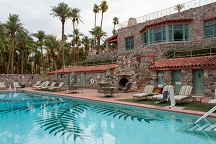 DENVER—Showcasing more than a decade of leadership while taking on the challenge of climate change, global hospitality company Xanterra Parks & Resorts has released its 2014 Corporate Social Responsibility Report, defining and measuring its innovative sustainability improvements. The report also announces ambitious stretch targets for the next decade.
DENVER—Showcasing more than a decade of leadership while taking on the challenge of climate change, global hospitality company Xanterra Parks & Resorts has released its 2014 Corporate Social Responsibility Report, defining and measuring its innovative sustainability improvements. The report also announces ambitious stretch targets for the next decade.
The report presents details of improvements measured against goals announced in 2004. The company tracks its environmental performance across all aspects of its operations using an ISO 14001 audited program launched in 2002.
Xanterra entities include lodges, restaurants, tours and activities in national and state parks, as well as resorts, a cruise line, railway and adventure tour companies. The company has experienced rapid growth in recent years, adding Windstar Cruises, Austin Adventures, Country Walkers, VBT Bicycling and Walking Vacations, Kingsmill Resort and the Grand Hotel.
 “As we reflect upon the 10 years of hard work required to meet our initial sustainability goals, we applaud the dedicated—and innovative—employees whose ideas and passion are often behind many of our success stories,” said Catherine Greener, Vice President of Sustainability for the company. “Although we have met and even exceeded many of our goals, we see opportunities for improvement. By carefully tracking and measuring our performance we can re-evaluate our many programs, recalibrate them as needed and continue on our important journey to leave a softer footprint in the places we manage and impact.”
“As we reflect upon the 10 years of hard work required to meet our initial sustainability goals, we applaud the dedicated—and innovative—employees whose ideas and passion are often behind many of our success stories,” said Catherine Greener, Vice President of Sustainability for the company. “Although we have met and even exceeded many of our goals, we see opportunities for improvement. By carefully tracking and measuring our performance we can re-evaluate our many programs, recalibrate them as needed and continue on our important journey to leave a softer footprint in the places we manage and impact.”
Addressing Climate Change
Xanterra took a leadership position to address climate change almost two decades ago as it became increasingly apparent that the warming of the world’s oceans and other signs of climate change were having a dangerous and disturbing impact on Xanterra locations. Since 2000, the company has reduced total fossil fuel consumption companywide by 29 percent and decreased greenhouse gas emissions by 27.5 percent. In 2004 Xanterra became one of the initial signatory members of the World Wildlife Fund Climate Savers program and the only national park concessioner to commit to the program’s goals. The company is the only national park concessioner and one of the few hospitality companies to sign the Ceres Climate Declaration, which identifies climate change as one of the greatest economic opportunities of the 21st century.
The company organizes its sustainability goals and efforts under four pillars: use resources efficiently and effectively; strive for zero waste; build and operate sustainably; and provide guests with sustainable choices. These pillars guide decision-making at every level of the company, including food and beverage sourcing for restaurants, choosing fleet vehicles and choice of paints for guestrooms.
The report identified many areas where the company exceeded or came close to meeting its goals set in 2004, including:
• Reduction of carbon emissions—exceeded.
• Reduction in water use—exceeded.
• Use of renewable energy—exceeded.
• Reduction of fossil fuels—came close.
• Waste diversion—came close.
Additionally, Xanterra made progress in meeting its goals to:
• Increase availability of sustainable cuisine.
• Eliminate hazardous waste.
• Meeting corporate average fuel economy (CAFE) standards.
The company’s goals for the next 10 years—2015 through 2025—include:
• Five percent reduction in energy use annually.
• Five percent reduction in water use annually.
• Fifty percent reduction in carbon emissions.
• Seventy percent increase in sustainable cuisine offerings.
• Twenty-five percent of assets certified landfill-free.
• Ninety-three percent overall guest satisfaction.
Programs That Have Resulted in Significant Successes
• Diversion of 30,000 pounds of food scraps at the South Rim of Grand Canyon National Park through the “Shrively Apple” program, which provides slightly shriveled apples and other waste to the park’s grateful mules, whose waste is then composted and turned into fertilizer for local farmers.
• Water recirculation at Zion Lodge where walk-in coolers were refitted with specially engineered cooling units that recirculate water.
• Installation of an electric vehicle recharging station at Zion Lodge.
• Installation of a wind turbine at Maumee Bay State Park Lodge.
• Replacement of incandescent lights with CFL and LED lighting at the Grand Canyon.
• Elimination of plastic water bottles on Windstar Cruises.
• Construction of Platinum LEED-certified employee housing in Yellowstone National Park on a reclaimed location that was formerly a contaminated brownfield site.
• Achieving LEED certification for a restaurant and gift shop in Crater Lake National Park.
• Renovation of historic Zion Lodge cabins balancing historical accuracy with modern energy and water efficiency improvements.
• Building a 1.23 megawatt solar photovoltaic system that generates 2.3 million kWh per year for Furnace Creek Resort in Death Valley National Park, one of the hottest places on Earth.
• Establishing retail stores with a large percentage of Made in America products.
• Maintaining four golf courses as Certified Audubon Cooperative Sanctuaries.
• Installing picnic tables at Yellowstone’s Canyon Lodge made from remnants of some 4,000 recycled glass bottles.
• Powering the No. 4960 steam engine at Grand Canyon Railway with waste vegetable oil.
• Providing waste food to feed bears housed at Bearizona near Grand Canyon Railway and Hotel.
• Using a gravity-fed system of natural spring water to flow from the spring-fed swimming pool to gardens and then golf course ponds at Furnace Creek Resort in Death Valley National Park.
• Encouraging guests to choose vacations with a softer footprint by bicycling with VBT Bicycling and Walking Vacations and Country Walkers instead of driving.
• Sourcing food aboard Windstar Cruises from local and sustainable farmers, fishermen and other sources.
• Partnering with a local goat farm to supply cheese to diners in Yellowstone National Park.
• Developing an ice cream made from locally sourced ingredients and based on a recipe by Thomas Jefferson at Mount Rushmore National Memorial.
• Offering locally made food, wine and beer at Crater Lake Lodge.
• Implementing a glass recycling program at Glacier National Park during Xanterra’s first year of operating concessions.
• Minimizing the use of disposable straws from most of Xanterra’s full-service dining rooms.
• Improving the way Xanterra communicates its sustainability programs to guests.
• Communicating to guests the visible impact of climate change at Glacier National Park and soliciting guests’ commitment to supporting Xanterra’s programs.
• Risk management, philanthropy and sustainability awards and certifications.
The report also provides details of some of Xanterra’s risk management programs and global philanthropy programs. Among the successful risk management programs cited in the report is a first responder program and emergency preparedness planning. Xanterra’s performance in the categories of loss rates and lost time rates both exceed industry averages.
Xanterra is also active in numerous local and global philanthropic programs such as community scholarships in the Grand Canyon, Windstar Cruises’ support for port communities, Yellowstone’s regional partnerships with a volunteer fire department, ambulance service and community Thanksgiving dinner. Other organizations supported by Xanterra include Protect the Flows, American Red Cross, Boy Scouts of America, Colorado Coalition for the Homeless, Ducks Unlimited, United Way and Ronald McDonald House.
Lastly, the report lists some of the numerous awards and certifications Xanterra has received for its sustainability programs.
The complete report is available online.






